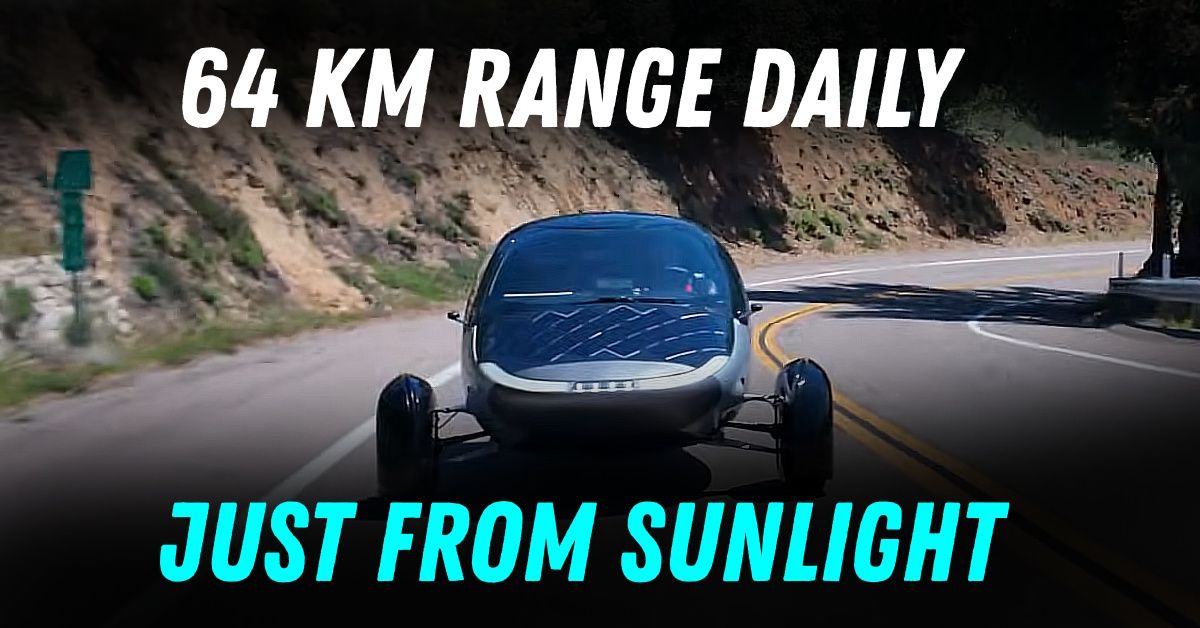Solar EV Gives 64 KM Range Purely From Sunlight: No Charging Needed


Imagine an electric vehicle that could run for days without ever needing to be plugged in. That’s not a scene from a sci-fi film—it’s a bold step into the future taken by Aptera Motors, a California-based startup betting big on solar power. Their latest prototype has completed a 300-mile road trip powered solely by sunlight, offering a fresh perspective on what personal mobility could look like in the coming years.
How did it do it? First, it got fully charged from sunlight using its solar panels. Then, during the trip, solar energy added an additional 22 miles (35 KMs).
Most electric vehicles still rely heavily on charging stations. Aptera, however, has turned the idea on its head by designing a car with solar panels built right into the body. These sleek, integrated panels stretch across the roof, bonnet, and rear of the car, generating up to 700 watts of electricity under ideal conditions.
In good sunlight, that’s enough to add around 40 miles of driving range per day—more than sufficient for daily urban commutes. Even under overcast skies, the vehicle managed to generate between 300 and 545 watts during a recent test drive on America’s historic Route 66, proving that it doesn’t need perfect weather to perform.
What makes Aptera truly stand out isn’t just the solar panels—it’s the radical design choices behind the car. Unlike most conventional EVs, this one runs on three wheels and has a teardrop-shaped body that looks more like a small aircraft than a hatchback. But it’s all about function over form.
Thanks to this design, the car has an incredibly low drag coefficient of just 0.13—far lower than even the most aerodynamic electric cars on the road today. That means it slices through the air with minimal resistance, using less energy to move forward.
It’s also remarkably light. Built from carbon fibre composites, the vehicle is roughly 60% lighter than typical EVs. Yet, despite the featherweight frame, it doesn’t compromise on strength or safety. The motors are housed directly inside the wheels, and the drivetrain is tuned for maximum efficiency. On paper, it delivers a jaw-dropping 10 miles per kilowatt-hour—over twice the efficiency of many mainstream EVs.
Aptera recently took this prototype on a real-world journey from Flagstaff, Arizona to California’s Imperial Valley. The drive covered varied terrain—mountain slopes, desert plains, highways packed with trucks—and the car handled it all without needing to plug in.
Some key takeaways:
• It maintained a consumption rate of just 122 watt-hours per mile, among the best in the industry.
• Solar power alone contributed an additional 20 miles of driving range during the trip.
• The car remained stable and reliable despite strong crosswinds and a heavier-than-final prototype weight.
This wasn’t just a test of technology—it was proof that the concept works on actual roads, not just in labs or simulations.
For most Indian car buyers, the idea of never having to charge your EV might sound too good to be true. But Aptera is designed to make that dream a reality—especially for those who drive short distances daily and have access to sunlight.
That said, for longer trips or during spells of bad weather, the vehicle still includes a traditional battery pack. The top variant has a 45 kWh battery that can be charged via a standard EV socket, with multiple versions planned offering anywhere between 250 to 1,000 miles of range on a full charge.
The starting price is expected to be around $40,000 (approximately ₹33 lakh), which makes it a premium product for now. But as with most new technologies, costs are expected to come down over time.
Of course, it’s not all smooth sailing. Aptera still faces a number of challenges before its vision becomes a mass-market reality.
First, funding. The company needs an additional $60 million to begin production and hopes to manufacture around 20,000 units annually by 2027. That’s an ambitious goal, especially for a startup.
Then there’s the matter of public acceptance. The three-wheeled, aircraft-like design might not appeal to everyone, especially those used to the look and feel of a conventional car. And while the compact size helps with efficiency, it also limits boot space and rear seating—potential drawbacks for families.
Lastly, solar technology, while promising, still depends on the weather. Overcast days or shaded parking spaces could reduce the solar contribution significantly. And integrating these high-efficiency photovoltaic panels into the vehicle body adds to the manufacturing cost.
Despite these challenges, Aptera’s prototype feels like a glimpse into what’s next. It’s one of the few attempts to make a car genuinely self-sustaining—at least for everyday needs.
For Indian buyers, especially those living in sunny states like Rajasthan, Gujarat, or Tamil Nadu, the idea of a solar car could be game-changing—especially if local production makes it more affordable down the line. With government support for cleaner mobility and a growing interest in EVs, there’s potential for this kind of innovation to catch on in India.
Aptera may not be a household name yet, but its vision could inspire other manufacturers to think beyond batteries and charging networks. If it succeeds, the future of personal transport might just be as simple as parking your car in the sun.